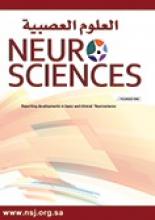Epilepsy is a common neurological disorder in Saudi Arabia, with a prevalence of 6.54 per 1000.1 The level of public awareness, and the attitudes and knowledge of epilepsy in the Saudi population is limited, and requires significant improvement.2,3 Limited epidemiological studies on epilepsy in Saudi Arabia are available.1,4 A recent survey carried out in Jeddah,3 a major city in western Saudi Arabia, showed that the residents of Jeddah seemed to accept patients with epilepsy, but are unaware of what epilepsy really means. The Jeddah survey, and another survey carried out in Riyadh,2 the capital of Saudi Arabia, showed that most of the survey responses were due to a misunderstanding of the disorder, and epilepsy education among the general population in Saudi Arabia is highly recommended and needed to improve the understanding of epilepsy, and therefore improve quality of life of epileptic patients.
The World Health Organization (WHO) estimates that 50 million people of all ages are affected by epilepsy worldwide with more than 85% living in the developing world. Roughly 4.7 million people with epilepsy live in the WHO Eastern Mediterranean Region.5 The social, physical, and psychological implications of epilepsy are a huge social stigma, and discrimination dominates social attitudes toward epilepsy. These sociocultural issues of epilepsy are important determinants of its clinical course, and often limit appropriate treatment.5 In developing countries, up to 90% of epileptic patients may not receive the treatment they require and this wide treatment gap remains a reason for tremendous individual, family, social and economic burden.5 The Global Campaign Against Epilepsy was launched in 1997 as a joint initiative of the WHO, the International League Against Epilepsy (ILAE), and the International Bureau for Epilepsy (IBE), with an overarching aim of bringing epilepsy “out of the shadows”. The Eastern Mediterranean Region launched its Declaration on Epilepsy in 2003. The declaration called on the governments of the Member States of the Eastern Mediterranean Region, national and regional, public, and private organizations, all health care providers, and the general public to participate in the Global Campaign Against Epilepsy to improve general awareness of epilepsy among the population and the policy-makers in an effort to reduce stigma, and bridge the current treatment gap for people with epilepsy in the region.
Today, in addition to advancing epilepsy management in Saudi Arabia through increasing numbers of specialized epilepsy centers with highly trained health-care providers and sophisticated medical equipment in different regions of the country, there are combined efforts among health sectors and national epilepsy societies and groups to improve public awareness in epilepsy. The yearly purple day celebration on the 26th of March is held in many cities in Saudi Arabia with many activities on this day, and where epilepsy patients of all ages with their caregivers meet epilepsy experts in the country and discuss related issues. In addition, several epilepsy awareness activities are conducted yearly through seminars, public media interviews, and publications. With those efforts, the awareness and attitudes of the Saudi public toward epilepsy are showing some improvement. However, it is still thought to be linked to evil spirit possession by some, and spiritual rituals, and religious healing are commonly believed to be effective treatments. Therefore, intensifying public awareness and education with targeted areas for focused education is highly recommended.6
- Copyright: © Neurosciences
Neurosciences is an Open Access journal and articles published are distributed under the terms of the Creative Commons Attribution-NonCommercial License (CC BY-NC). Readers may copy, distribute, and display the work for non-commercial purposes with the proper citation of the original work.






